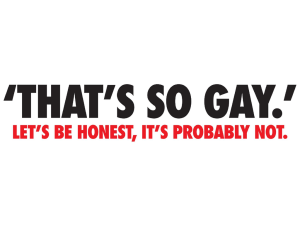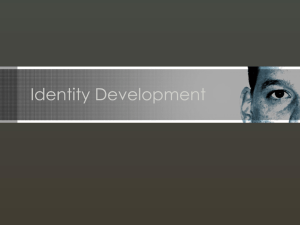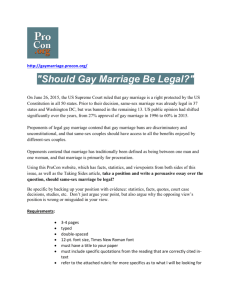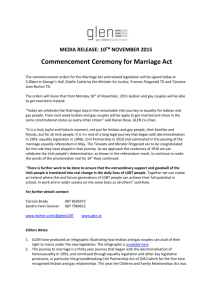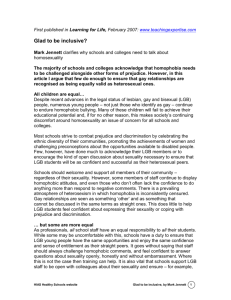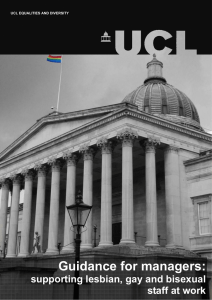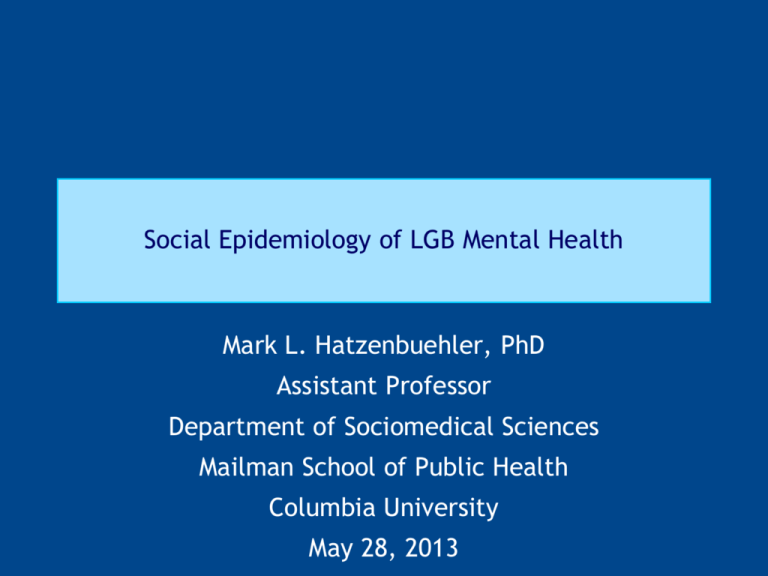
Social Epidemiology of LGB Mental Health
Mark L. Hatzenbuehler, PhD
Assistant Professor
Department of Sociomedical Sciences
Mailman School of Public Health
Columbia University
May 28, 2013
Multi-Level Determinants of LGB Mental Health
Structural
State Policies, Institutional Practices
Interpersonal
Peer Relations, Family Support
Individual
Emotion Regulation
Level 1
Level 2
Level 3
Social Policies as Structural Determinants of LGB
Mental Health
Approach #1:
Are Mental Health Problems Higher among LGBs Living
in Areas without Protective Policies?
Oregon Counties
Proportion of school districts with anti-bullying policies that were inclusive of sexual orientation in 34 Oregon counties
Oregon Healthy Teens (OHT) Study
• Linked ecologic data on inclusive anti-bullying policies at the
county level to individual health outcomes among lesbian and
gay youth living in these counties
• Health and sexual orientation data from OHT study
• Annual surveys to over 1/3 of Oregon’s 11th grade public school students
• Modeled on Youth Risk Behavior Surveillance studies from CDC
• N=31,852 11th grade students (2006-2008)
• N=301 lesbian and gay respondents
• Outcome measure: any suicide attempt in the past year (Brener et al.,
1995; 2002)
Highest Risk of Suicide Attempts in Counties with
Lowest Proportion of School Districts with Inclusive
Anti-Bullying Policies (Lesbian and Gay Youth)
30
25
Percentage
Attempting
Suicide in Past
Year
20
15
10
5
Low
Medium
High
Inclusive Anti-Bullying Policies (Tertiles)
OR=2.25, 95%CI=1.13, 4.49
Hatzenbuehler & Keyes, (in press), J Adolesc Health
Antibullying Policies Remain Associated with Suicide
Attempts Independent of Individual-Level Risk Factors
(Generalized Estimating Equation Models)
Hatzenbuehler & Keyes (in press), J Adolesc Health
Approach #2:
Do Mental Health Problems Increase Following the
Enactment of Exclusionary Social Policies?
Constitutional Amendments Banning Same-Sex Marriage
(2004)
NESARC (2001-2005)
•
Red = States passing
constitutional
amendments
•
Blue = States not
passing
constitutional
amendments
National Epidemiologic Survey on Alcohol and Related
Conditions (NESARC)
•
Wave 1 (N=43,093)
•
Wave 2 (N=34,653)
•
Household and group
residents
•
Face-to-face interviews
•
Response rate: 81%
•
Oversampling of Blacks,
Hispanics, young adults
(18-24 yrs)
•
DSM-IV diagnoses
•
Sexual orientation (1.67%
LGB-identified [1.86% men,
1.52% women])
LGB Adults Living in States that Banned Same-Sex
Marriage Experience Increase in Mood Disorders
36.6% increase
40
30
23.6% decrease
20
10
0
Wave 1
Gay MarriageNo Marriage Ban
Ban (N=135)
AOR = 1.67 (95% C.I. 1.01,2.77)
(N=442)
Wave 2
AOR = 0.69 (95% C.I., 0.47,1.01)
Effect of Marriage Bans are Specific to LGB Adults
36.6% increase
2.6% increase
AOR = 1.67 (95% C.I. 1.01,2.77)
AOR = 1.03 (95% C.I. 0.93,1.15)
Intervention Implications
• Social-structural factors:
• Represent targets for structural interventions
• School policies (antibullying, Gay-Straight Alliances)
• State policies (marriage, employment nondiscrimination)
• Serve as moderators of intervention effectiveness
• HIV interventions to improve African Americans’ condom use
practices were only effective in communities with low levels of antiBlack prejudice (Reid, Dovidio, Ballester, & Johnson, in press)
• Similar process may occur with LGBT populations
Acknowledgments
Funders
• National Institute of Drug Abuse (K01 DA032558)
• National Institute of Mental Health (F31 MH834012)
• American Public Health Association (Walter J. Lear Award, Kenneth
Lutterman Award)
• American Psychological Association (Maylon-Smith Dissertation Award)
• Williams Institute at UCLA School of Law
• Robert Wood Johnson Foundation Health & Society Scholars program
• Center for Population Research In LGBT Health
Collaborators
• Jack Dovidio, Susan Nolen-Hoeksema (Yale)
• Deborah Hasin, Katherine Keyes, Bruce Link, Jo Phelan (Columbia)
• Kate McLaughlin (Harvard)
• Steve Safren, Ken Mayer, Judy Bradford, Conall O’Cleirigh (Fenway)

